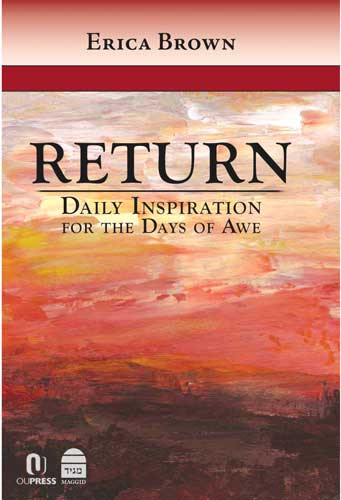.jpg)
This excerpt was taken from Return: Daily Inspiration for the Days of Awe by Erica Brown. It was reprinted with permission from Maggid Books, a division of Koren Publishers Jerusalem. Return is available at all Jewish bookstores and online. See www.korepub.com for more info.
Rabbi Jonah of Gerona (d. 1263) called repentance a sanctuary, a place to escape the intensity of sin. It is also the place to embrace the strength needed to fight our hardest inner battles and our stubborn resistance to change. By calling repentance a sanctuary, Rabbi Jonah, in Sha’arei Teshuva (The Gates of Repentance), transformed an act into a space we can step into and know that we are home and we are safe. We have returned to our essential selves, the people we like best. We are at one with forces that usually rage within us, pulling us between good and evil, generosity and self-absorption, selflessness and narcissism.
Almost 800 years later, Rabbi Joseph Soloveitchik, too, described the sanctuary of teshuva and how it envelops us on these holiest of days:
“Jews do confess, but confession is a private matter between the individual and the Almighty. In my opinion, this is because of the Jew’s typical modesty and shyness. The noblest and most exalted feelings that the Jew experiences must remain like the Ark of the Covenant, concealed behind the curtain. ‘And the curtain shall separate for you between the holy and the Holy of Holies’ (Exodus 26:33). The sanctuary of the human person is his emotional life, not his logical life. The Ark is with us in each person’s emotional life, concealed behind the curtain.”
Sometimes this Ark is so concealed that it is not always easy to locate our sanctuary of repentance. Even though we may be painfully aware of the need to change, we may lack the tools, the resilience, or the commitment to take on the demons of a dificult past or the challenges that come with the future. Rabbi Jonah was deeply concerned with those who put of the process of change and improvement, believing that such individuals only intensify their own problems: “Deferment of repentance is found only among the ignorant, who lie asleep and do not commune with their hearts, and who possess neither the knowledge nor the under- standing to hasten to save themselves.”
Those who know how to repent are those who can commune with their hearts, who can recognize with exquisite sensitivity where they are falling short of the mark. The rest of us lie asleep even when we are awake. We fail to save ourselves.
Rabbi Jonah offers us more than inspirational messages. To be efective, teshuva must move us all the way from regret to a place of profound change. The change must make us so distant from where we once were, that we are actually able to instruct and guide others to avoid what was once a major source of personal temptation or spiritual weakness in ourselves. It is as if we were to look at an old photograph of ourselves. We recognize the image and the likeness but also know that we are not that same person anymore. Rabbi Jonah presents the anatomy of an apology as an outline for transformation in his table of contents, offering twenty steps that contribute to the process of true change.
This list presents both the range of emotions that it takes to enter the sanctuary of repentance and the behavior that must emerge from these emotions…Humility is essential for a complete understanding of sin’s influence. Without it, we may just write of the dimensions of a problem, not discovering its deeper causes and its far-reaching tentacles. The very last sentence in The Gates of Repentance is a verse from Psalms that captures the corrosive impact of sin: “The magnitude of sin is too heavy for me” (65:4). Sin weighs us down. It blocks us from moral advancement, chaining us to a stubborn soul, a recalcitrant heart.
Rabbi Jonah knew the process of teshuva intimately because he himself needed it. In 1233, Rabbi Jonah instigated a book-burning of Maimonides’ most controversial work, The Guide to the Perplexed, in France. The Aristotelian overtones of the book felt foreign to many rabbis, and they worried about the impact this would have on the faith of their flocks. When 24 cartloads of handwritten volumes of the Talmud were put on trial in 1240 and then burned publicly in Paris two years later, Rabbi Jonah regretted his involvement in the initial book-burning. Rabbi Jonah seemed unable to forgive himself for condemning a great Jewish scholar, perhaps believing that this paved the way for future ecclesiastically driven book-burnings and anti-Semitic acts…
Teshuva is a never-ending process because we are always changing and the context of our universe is always shifting. This does not mean that there is no stable or true self—to disagree with Heschel Rosenheim; we know when we are being true to ourselves. We need multiple opportunites for teshuva because our mistakes and errors change over time, and our circumstances are fluid. The self is not static and unchanging, even if our essential personalities may be well established. Events change us. Relationships change us. Decisions change us. Life changes us. Therefore, there can never be an end to the process of teshuva.








